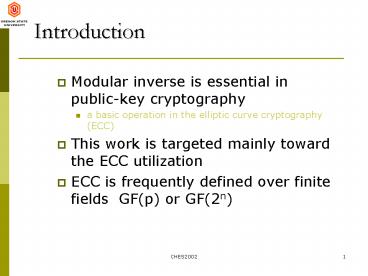Modular inverse is essential in publickey cryptography PowerPoint PPT Presentation
1 / 18
Title: Modular inverse is essential in publickey cryptography
1
Introduction
- Modular inverse is essential in public-key
cryptography - a basic operation in the elliptic curve
cryptography (ECC) - This work is targeted mainly toward the ECC
utilization - ECC is frequently defined over finite fields
GF(p) or GF(2n)
2
Motivation
3
Previous Work
- Several designs for GF(2n) only
- Hasan (2001)? word-by-word design
- gtgt small area
- Takagi (1993) inverse algorithm with a redundant
binary representation (GF(p)) - large area and expensive data transformation.
- Goodman and Chandrakasan (2001) processor that
performs inversion in both GF(p) and GF(2n) - reconfigurable, designed for low power,
- large area.
4
Scalable Architecture
- Features
- Short designs longest path, independent of
operand precision - Design area adjustable to available space
(flexible) - Allows the computation with virtually infinite
precision (limited only by memory).
5
Why Scalable Hardware?
Computes 10 bits at each clock cycle
Able to handle 1000 bits maximum
6
Unified architecture
- Definition An architecture is said to be unified
when it is able to work with operands in both
prime and binary extension fields (GF(p) and
GF(2n))
7
Modular Inverse (Extended Euclidean Alg.)
Phase I Input a ? 1, p -1 and p Output r
? 1, p -1 and k, where r a-12k (mod p) and n
? k ? 2n 1. u p, v a, r 0, and s 1,
2. k 0 3. while (v gt 0) 4. if u is even
then u u/2, s 2s 5. else if v is even then
v v/2, r 2r 6. else if u gt v then u (u
- v)/2, r rs, s 2s 7. else v (v -
u)/2, s sr, r 2r 8. k k 1 9. if r ?
p then r r - p 10. return r p - r
8
Modular Inverse (Extended Euclidean Alg.)
Phase II Input r ? 1, p -1, p, and k (r and
k from phase I) Output x ? 1, p -1 where x
a-12n (mod p) 11. for i 1 to k - n do 12. if
r is even then r r/2 13. else r (r
p)/2 14. return x r
9
Montgomery Modular inverse
Based on Extended Euclidean Algorithm
10
Montgomery inverse hardware algorithm for GF(p)
ISVLSI-2002
11
The scalable hardware
12
GF(2n) Features
- a(x)an-1xn-1an-2xn-2 ... a2x2a1xa0, where
ai?GF(2) - a(an-1 an-2 ... a2 a1 a0)
- - in GF(p) ? ? in GF(2n)
- p(x)xnpn-1xn-1pn-2xn-2 ... p2x2p1xp0
- p(1 pn-1 pn-2 ... p2 p1 p0)
- a(x) p(x) (degree of a(x) degree of
p(x)) ? ap?a - Normal Subtraction (carry propagate) for degree
testing
13
GF(2n) Montgomery inverse
14
Montgomery inverse hardware algorithm for GF(2n)
15
Scalable and unified inverter hardware
16
Experimental Results
- VHDL ? functional simulation
- Maple verification.
- Leonardo (Mentor Graphics) synthesis
- 0.5 Micron CMOS technology - ASIC Design Kit
(ADK) - VHDL code compiled to obtain estimates for
- Area ? the number of gates
- Clock Period?Longest path delay (nanoseconds)
17
Area Comparison
18
Speed Comparison (nmax512 bits)
AVG cycles Cf 1.53n Cs (2.4n1)e e
words TimeCcycle_time
19
Speed Comparison (nmax512 bits)
Technology independent
20
Conclusions
- A scalable and unified architecture that operates
in both GF(p) and GF(2n) fields was proposed. - Adjusted a GF(2n) MonInv algorithm to include the
multi-bit shifting method making it very similar
to a previously proposed GF(p) inversion hw
design. - A comparison of the scalable unified design
with a reconfigurable hardware shows that the
scalable design saves a lot of area and operates
at comparable speed. - Scalable/unified design has similar or better
performance than a fixed-precision design, with
significantly less area. - Small extra cost to add unified design feature to
previously proposed design for GF(p)
only.(around 8.4).

